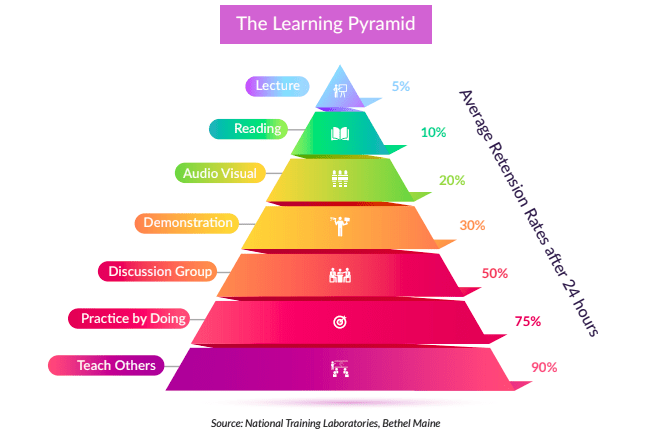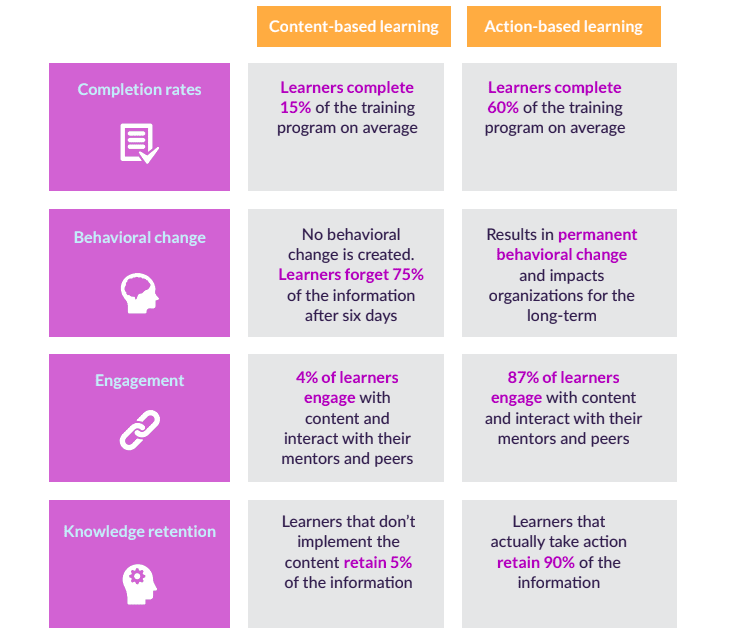Bridge the Gap Between Corporate Training and Real Work Outcomes

As a learning and development professional, you’ve been hearing about “engagement” and “engaging learners” for some time now — you know why it’s important, and you’re fully aware of the benefits. You’ve witnessed first-hand the shift in corporate learning towards engagement, with learning and development (L&D) leaders turning more and more to Learning Experience Platforms (LXPs) and personalized learning paths rather than traditional Learning Management Systems (LMSs).
Engagement is indeed crucial to training’s success, but it’s definitely not enough. It must be backed up by real, actionable learning in order to create lasting impact. Learners who engage with training content might remember it better and enjoy it more, but it doesn’t mean they’re able to implement the information and use it after the training ends.
Action-based learning helps you bridge the gap between training and real work outcomes — and get the transformational impact you’re after.
Why Content-Based Learning Fails: a Look at the Numbers
Corporate learning is often broken, with next to no knowledge retention, poor completion rates, making difficult to measure ROI. This is the reality of training today:
- 5% of learners complete their training (excluding mandatory training)
- 87% of training is forgotten within one month of training
- 80% of new skills are lost within one week of training if not used
These poor stats show that training programs are often designed in a way that’s inherently flawed. Most companies today use content-based methods, which means content is delivered to learners in a passive way, without any focus on the things that make learning happen: actions, interaction, and feedback.
If learners only practice passive forms of learning such as reading and listening, they won’t get far. Brains are terrible at memorizing information encountered only occasionally. Why? Because our brain’s perception-action cycle must be activated in order for information to be properly processed. To activate this cycle, we need to take action, get informative feedback, and adjust our thinking until we figure out the best way to complete the action successfully. Active learning and problem solving lies as the foundation learners need to succeed in their work.
What’s Action-Based Learning?
Action-based learning means learners take what they learn and put it into practice. This is one of the most effective methods of retaining knowledge and skills as it leads to a more in-depth understanding of material, higher retention rates, and better recall.
According to the Learning Pyramid, developed by the National Training Laboratory, most learners only remember about 10% of what they read from textbooks, but retain 75% of what they learn by doing.

When designing corporate training programs, try to stay away from passive forms of learning such as reading and lectures. Encouraging employees to teach one another, practice by doing, and participate in discussion groups will help maximize knowledge retention rates and training ROI.
Why Action-Based Trumps Content-Based
In today’s competitive work environment, organizations that train employees in the most effective and efficient ways possible will always gain the upper hand. Action-based learning develops employees’ capacity to adapt to new situations, bridges the gap between theory and practice, and delivers a stellar ROI for the company.
Here are some of the key differences between content-based and action-based learning:

Content-based training platforms and systems might give employees the illusion of having knowledge, but at the end of the day they’re only going to remember 5% of what they learned. So, what would the ideal platform to train employees and make sure they really retain knowledge look like?
A New Approach To Training: Go Action-Based or Go Home
Asking employees to put what they learn into practice isn’t enough. For learning to be active and transformative, employees need to:
- Enjoy the learning process
- Form new habits and adopt new behaviors
- Receive feedback from their managers and peers
- Feel motivated to move forward
The ideal training platform would use actions as part of the learning process and provide various opportunities to get feedback, coaching, and peer mentorship for improvement. It would trigger learners to make progress and achieve their learning goals.
“When you study alone, you typically remember 28% of what you learned after two days. When you repeat the material, you remember 46%. But when you use it, answer questions about it, and interact with others, you remember 69%. “
Josh Bersin, Industry Analyst and Founder of Bersin by Deloitte
But in an engagement-focused era where it’s all about content, how do you deliver learning in a way that’s focused on actions?
How to Recreate Online Training
Here’s how you can incorporate actions, feedback, and triggers as a requirement for real action-based learning to take place, no matter what technology or platform you are using.
Action
Turn training content into an experiential learning journey.
- Actionable missions: Replace lessons with missions, allowing employees to remain active throughout the process.
- Habit formation tools: Help employees form new habits to create long-lasting behavioral change that leads to transformation in the company.
- Gamification: Turn the learning experience into a fun and engaging journey. Have employees complete missions, level up, and get rewards.
- Micro-learning: Deliver content in bite-sized chunks to make it easier for employees to understand and digest information.
Feedback
Help employees improve their performance and increase motivation and engagement.
- Community learning: Allow employees to support, give feedback, and encourage one another.
- 1:1 coaching: Provide a personal learning experience, allowing employees the opportunity to grow and improve.
- Buddy support: Enable peer to peer support and encourage collaboration in the organization.
Trigger
Sustain learning and keep employees excited about what they learn.
- Push notifications: Send automated push notifications based on progress to keep employees motivated.
- Reminders: Send reminders and alerts to employees who are not completing their habits or fall behind.
There are tools available, such as the myQuest, that embrace this Action-Based Training methodology worth looking into for your next training program. As a business leader, it’s important to remember that actions reinforce behaviours, so consider action-based training the next time you discuss professional development or other training with your team to ensure results.
Author Bio:
 Billy Mike is a learning engagement expert, and has been working as an instructional designer for the last several years at myQuest. In her time working at myQuest she’s written multiple ebooks that are centered around action based learning. She believes the way people learn impacts the way they think, and that REAL learning is possible through the right digital formats.
Billy Mike is a learning engagement expert, and has been working as an instructional designer for the last several years at myQuest. In her time working at myQuest she’s written multiple ebooks that are centered around action based learning. She believes the way people learn impacts the way they think, and that REAL learning is possible through the right digital formats.
